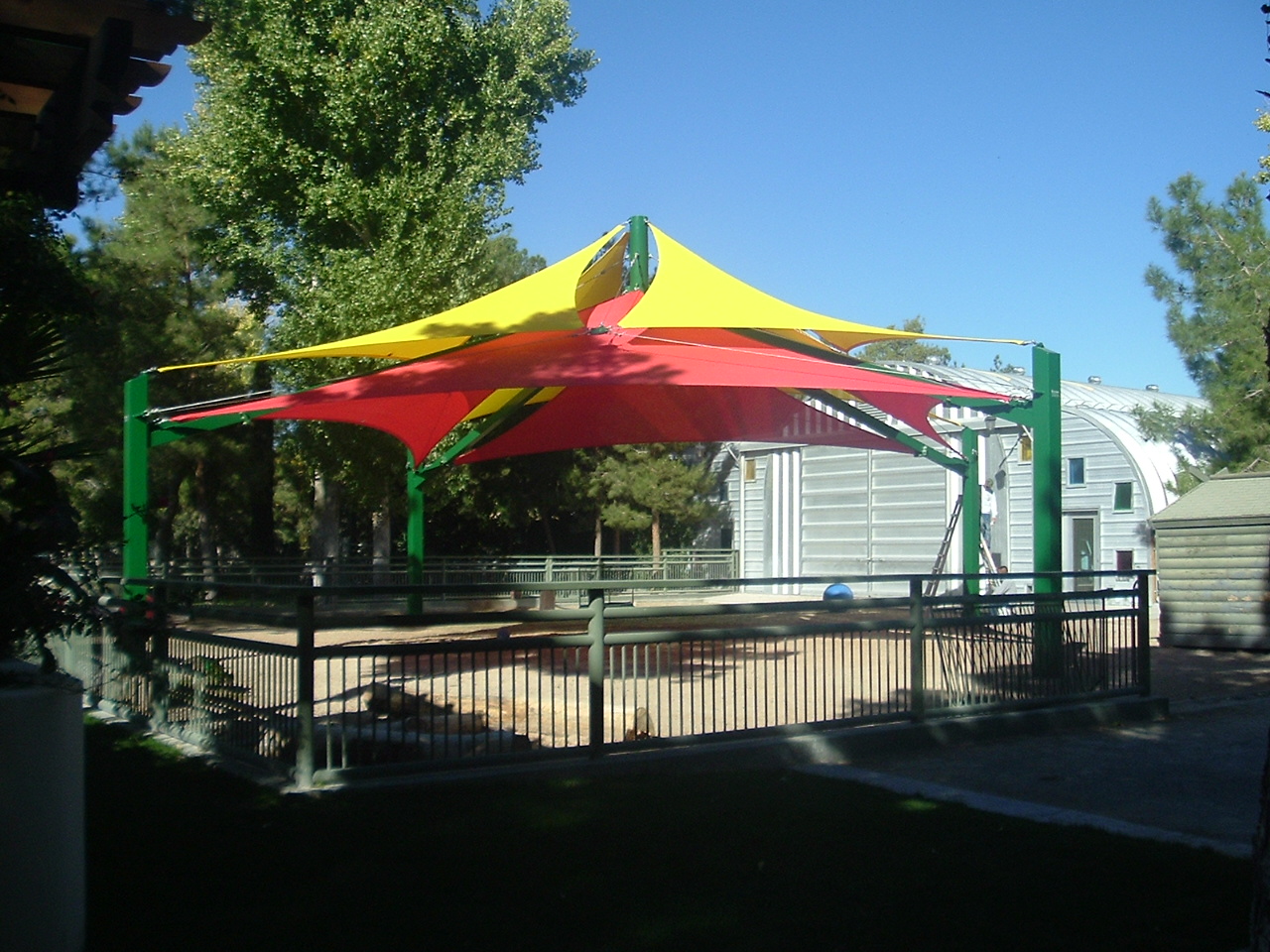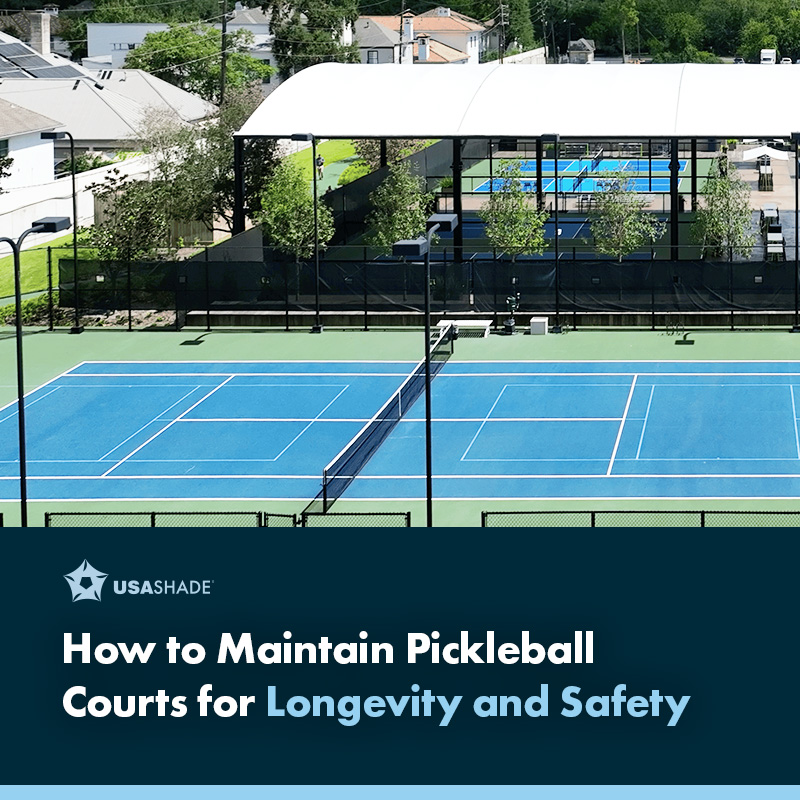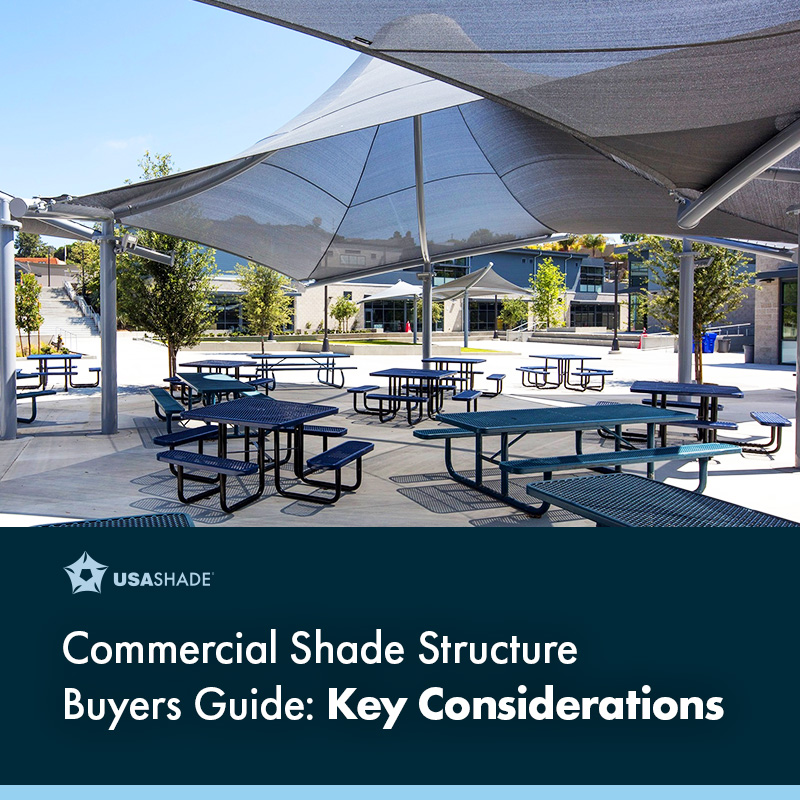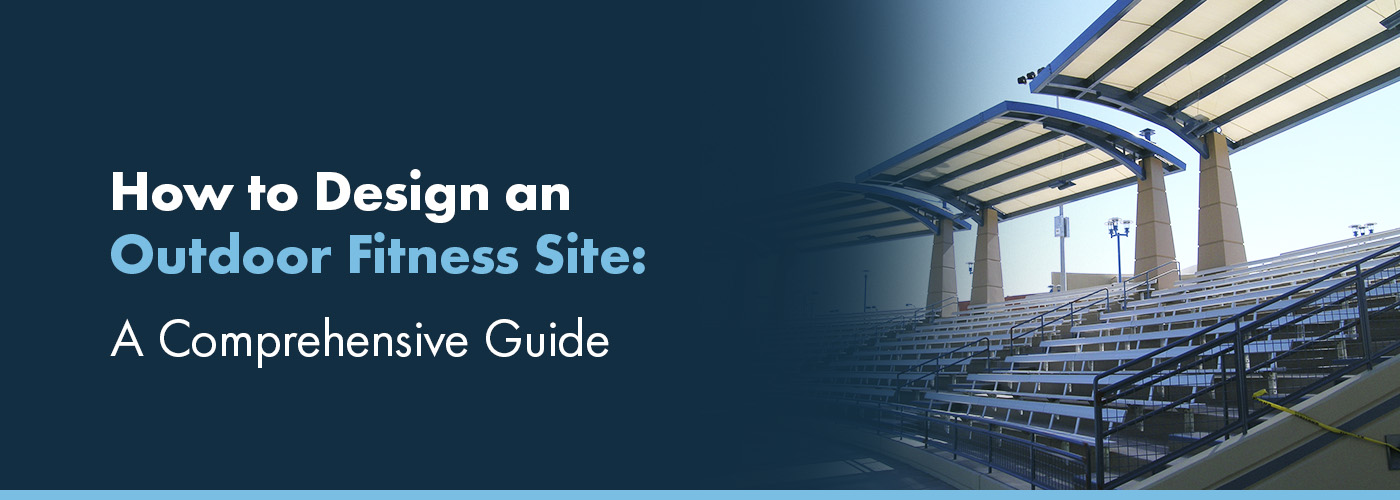
Outdoor fitness sites are one of the hottest outdoor exercise trends taking the U.S. by storm. Judging by the list of benefits they provide, their number will keep growing. But building an outdoor fitness space is about more than throwing up a set of parallel bars and a bench press. It involves transforming a static area into one of movement, inclusivity, elevated aesthetics and long-term sustainability.
Designing the ultimate outdoor fitness space requires thoughtful planning and a fair amount of work, but the effort pays off in a vibrant, high-use space and a healthier, connected community.
This guide walks you through every step, from initial planning to ribbon-cutting day, and offers innovative ideas to give your space additional appeal and longevity.
Why Designing an Outdoor Fitness Park Is Worth It
Americans are on the move in record numbers. Just under 176 million participants, representing 57.3% of the U.S. population, take part in outdoor recreation, with outdoor fitness sites popular for these reasons:
- Physical activity is accessible to everyone, encouraging healthier lifestyles and reducing barriers to exercise.
- Spaces open to the public remove cost and membership obstacles, and they welcome users of all ages and abilities.
- Social interaction, group workouts and community events strengthen neighborhood connections.
- With the right design and shade structures, these spaces can be used year-round.
- Exercising outdoors has specific health benefits compared to indoor environments — exposure to sunlight and green spaces can relieve stress, and being outdoors boosts vitamin D.
- Outdoor fitness sites meet the unique needs of each community, from equipment selection to layout and accessibility.
- Less maintenance and staffing are required than in indoor facilities, making outdoor exercise spaces a smart investment for cities and organizations.
Defining Purpose
The foundation of any successful outdoor fitness site is a deep understanding of the community it serves. Planning an outdoor fitness space starts with gathering data on age groups, fitness levels and interests within the community.
Survey local health data or consult with public health officials to understand community wellness challenges. Involving local residents, schools, senior centers and fitness professionals in the planning process can provide information and valuable insights. Recognize cultural preferences, popular sports and social habits that will influence how the space is used — like group classes, walking clubs or family gatherings.
Use surveys, focus groups or public meetings to ensure the site reflects real community desires. Once you know whether the site will serve families, seniors, youth or a mix, along with exactly how it will be used, you’re ready to start planning the outdoor fitness space.
How to Plan an Outdoor Fitness Site
Choosing the right location and planning the layout are critical to the success of outdoor fitness site planning. Location and layout enhance user experience and ensure the site is safe, accessible and seamlessly integrated into the broader community. Here’s how to approach the planning process for maximum impact.
Evaluate Location, Climate and Site Constraints
Careful evaluation of site-specific factors helps you avoid costly mistakes and ensures the space is inviting year-round.
Start outdoor fitness site planning by assessing how sunlight moves across the site throughout the day and year. Prioritize locations that allow for natural shade or can accommodate shade structures to protect users and equipment from excessive heat and UV exposure. Account for prevailing winds, which can affect comfort and safety. Plan landscaping, windbreaks or the orientation of equipment to minimize sun and wind-related discomfort.

Avoid low-lying areas prone to flooding or poor drainage. Can the site be graded or surfaced to prevent water accumulation and maintain dry conditions?
Choose a location that is easily accessible by foot, bike, car or public transportation. Convenient access encourages higher usage and supports inclusivity. However, choose a site away from busy roads or hazardous areas, and consider how visible the area is from nearby paths or facilities to enhance user safety.
Blend With Existing Park or Community Infrastructure
A well-integrated fitness site uses existing amenities and encourages broader community engagement. Thoughtful placement can turn a fitness area into a vibrant hub of activity.
Position the fitness site along popular walking or biking routes to attract spontaneous users. A site located near playgrounds, picnic areas or sports fields will encourage multigenerational use and family participation. Consider how the site can support or host group fitness classes, wellness events or partnerships with local organizations.
Plan for access to water, electricity if needed for lighting or equipment, and maintenance vehicles. This supports long-term upkeep and the potential for future enhancements.
Promote Accessibility and Inclusivity
An inclusive fitness site welcomes users of all ages and abilities so everyone in the community can participate and benefit from outdoor exercise. This can be achieved with:
- ADA compliance: Design the site to meet or exceed Americans with Disabilities Act (ADA) standards, including accessible routes, surfacing and equipment.
- Accessible paths and entrances: Provide wide, smooth and gently sloped pathways from parking or transit stops to the fitness area. Avoid steps or barriers that could impede access.
- Inclusive equipment selection: Consider how to design an outdoor gym with equipment that accommodates a range of abilities, including adaptive or wheelchair-accessible options.
- Clear and accessible signage: Use large, high-contrast text and universal symbols to communicate instructions and safety information. Consider braille or tactile signage for users with visual impairments.
- Rest areas and shade: Incorporate shaded seating and rest zones for users who may need breaks. This will support comfort and extended use for all.
The Role of Shade Structures at Outdoor Fitness Sites
Shade structures are sometimes overlooked when building an outdoor fitness space, but they are essential for comfort, safety and the longevity of the site. They enhance usability, protect users and equipment and add visual appeal.
UV Protection for Users
High-quality shade fabrics significantly reduce exposure to harmful ultraviolet rays. A shaded environment encourages users to exercise for longer periods and return more frequently. Include shade structures for rest and seating areas.
Equipment Protection From Weather
Shade structures shield fitness equipment from direct sunlight, rain and debris. This protection helps prevent fading, cracking and other weather-related damage. As a result, equipment lasts longer and maintains its appearance and functionality.
Temperature Regulation
By blocking direct sunlight, shade structures lower ambient temperatures in workout zones. This creates a more comfortable environment for users, even during the hottest months. Cooler conditions also help prevent overheating and dehydration.
Extended Usability Hours
With effective shade, outdoor fitness sites can be safely used during peak sun hours and in a wider range of weather conditions. This extends the hours of operation and increases accessibility for all users. More usable hours mean greater community engagement and return on investment.
Types of Shade Structures
When designing an outdoor fitness park, selecting the right type of shade structure is essential for balancing functionality, aesthetics and user comfort. Popular shade structures include:
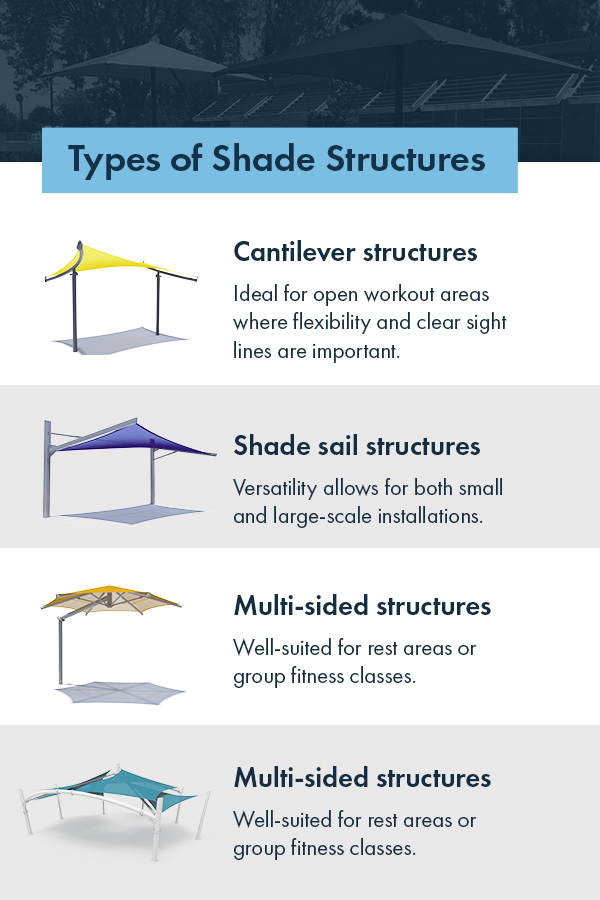
- Cantilever structures: These feature minimal posts, providing unobstructed space beneath for exercise and movement. Cantilever designs are ideal for open workout areas where flexibility and clear sight lines are important. Their sleek profiles also enhance the site’s modern aesthetic.
- Shade sail structures: These structures have a contemporary look with flexible, angular designs that can be arranged in creative configurations. They provide effective coverage and visual interest, making fitness sites stand out. Their versatility allows for both small and large-scale installations.
- Multi-sided structures: These structures add architectural character and can serve as gathering points or multipurpose shelters. They are a great option for large or irregularly shaped areas, offering shade and a sense of place. They are well-suited for rest areas or group fitness classes.
- Custom-designed solutions: Custom shade structures are tailored to your site’s specific needs and branding. They can incorporate unique shapes and colors to reflect community identity. A customized shade structure fits perfectly with the site’s layout and goals.
How to Design an Outdoor Fitness Center Aesthetic
A fitness site should reflect the character of its community and blend seamlessly with its surroundings to elevate the user experience and create a sense of place.
Collaborate with design professionals to ensure the site meets its functional and aesthetic goals. Landscapers and architects can advise on shade structures, innovative layouts and materials. This could include the best surfaces and equipment for older adults, focusing on balance, mobility and functional strength exercises. Sprint tracks and color-coded training zones can also categorize exercise intensity.
Include colors, themes, architectural features and indigenous plantings to promote a sense of pride and identity.
Sustainability and Long-Term Value
When considering how to design an outdoor fitness area, keep sustainability in mind. Sustainable design means focusing on eco-friendly materials, energy-efficient equipment and practices that minimize environmental impact.
You can achieve this in a few ways:
- Select durable, low-maintenance and recyclable materials, when available, for equipment and shade structures. Consider steel and fabric for longevity and environmental benefits.
- Plan for routine inspections, cleaning and repairs. Choose products with proven durability and support from reputable manufacturers.
- Design with green infrastructure, native landscaping and energy-efficient lighting to promote sustainability and wellness.
Navigating the Design and Installation Process
Designing an outdoor fitness park requires thoughtful planning, strong collaboration and capable execution. By understanding each phase of the process and engaging the right partners, your project can move smoothly from initial vision to a vibrant, completed space.
Collaborating With Distributors, Architects and Project Managers
Engage all key stakeholders — distributors, architects and project managers — early in the process to align on project goals, timelines and individual responsibilities. Early collaboration helps pinpoint potential challenges, streamlines decision-making and makes sure everyone is working toward a shared vision.
The Turnkey Approach: From Concept to Completion
Choose partners who offer a turnkey solution, managing every aspect of the project from initial design and engineering to manufacturing and installation. This approach simplifies coordination, reduces the risk of miscommunication, and assures consistent quality and service.
Project Management Best Practices
Set clear milestones and deliverables early on to keep the project on schedule and within budget. Maintain open, regular communication among all team members so questions or concerns can be handled quickly. Proactive monitoring and flexibility allow you to adapt to challenges so your project stays on track and meets your community’s needs.
Trends in Outdoor Fitness
Being aware of current trends can help you design the ultimate outdoor fitness space that stays relevant, attractive and effective in meeting community needs in the long run. Plan and design with these trends in mind:
- Exercising for mental health: Physical activity can boost mood, ease anxiety and depression and improve mental health. This is a major benefit of exercising in outdoor green spaces, and it’s largely why outdoor fitness zones will continue to grow in popularity.
- Functional fitness: Functional fitness mimics real-life situations to build strength and stability and improve the ability to perform daily tasks. Exercise examples include squats, dead lifts, walking while carrying weights and pull-ups.
- Fitness for older adults: The fitness industry is responding to the needs of a growing and aging population. Outdoor fitness zones that safely mimic walking on uneven surfaces, navigating steps and balancing will become increasingly popular.
- Technology integration: Gen Z and millennials view fitness as a high priority. They’re also tech-savvy and value an interconnected fitness experience. To enhance their experience, incorporate smart features like solar lighting, Wi-Fi and activity tracking.
The integration of technology, flexible layouts and visually striking shade structures is shaping the future of outdoor fitness zones. To fully realize your site’s potential, it’s essential to work with partners who understand these trends and can deliver solutions for your unique needs.
Why Choose Professional Shade Solutions by USA SHADE?
Here’s how USA SHADE supports your project every step of the way:
Expert Consultation Services
USA SHADE offers expert guidance from the initial concept through to final design. Our team works closely with clients so every detail aligns with project goals, streamlining the planning process and delivering optimal results.

Custom Design Options
Clients can choose from a wide range of custom design options to create unique, site-specific shade structures. These solutions reflect the character and needs of your community, enhancing functionality and visual appeal.
Professional Installation
USA SHADE’s professional installation teams ensure every structure is safely and efficiently installed. Their expertise includes compliance with relevant codes and standards, providing peace of mind and ensuring long-term performance.
Long-Term Durability
All USA SHADE structures are engineered for strength and resilience, built to withstand the elements over time. Durable materials and expert craftsmanship minimize maintenance needs, protecting your investment and allowing the community to continue to benefit from the space.
USA SHADE Has Your Outdoor Fitness Site Covered
Selecting the right partner is crucial when building an outdoor fitness space. USA SHADE stands out for its expertise, innovation and commitment to quality.
We offer market leadership, custom capabilities and a partnership approach. Your project benefits from decades of experience, a turnkey process and a collaborative mindset that puts the success of your outdoor fitness center first.
Ready to discover how expert shade solutions can elevate your outdoor fitness site and serve your community for years to come? Contact us today to take your vision to reality. Whatever your dreams, we’ve got you covered!


